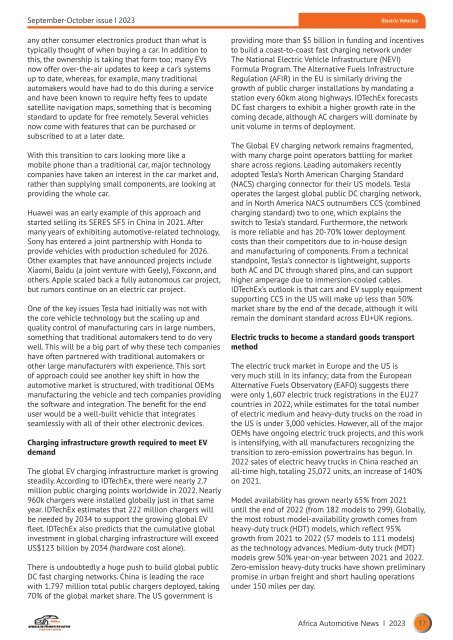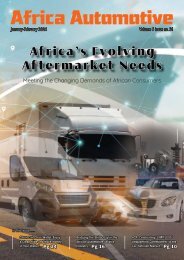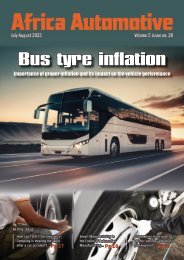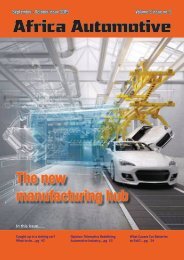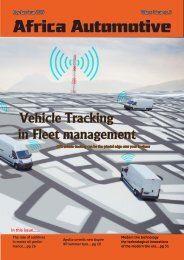Africa Automotive September-October 2023 digital issue
Africa Automotive prides itself to be the ONLY Africa’s leading and MOST authoritative magazine for the automotive industry in Africa with printed copies for the automotive industry decision makers in both government, NGO’s and private sector. The Bi-monthly magazine offers cost effective advertising services that get results and improves growth in the auto B2C and B2B sector, keeping an eye on latest technologies in Africa and across the world, the magazine predominately covers the developments in the Africa auto industry.
Africa Automotive prides itself to be the ONLY Africa’s leading and MOST authoritative magazine for the automotive industry in Africa with printed copies for the automotive industry decision makers in both government, NGO’s and private sector. The Bi-monthly magazine offers cost effective advertising services that get results and improves growth in the auto B2C and B2B sector, keeping an eye on latest technologies in Africa and across the world, the magazine predominately covers the developments in the Africa auto industry.
- TAGS
- automobile
- lubricants
- exhaustspipes
- automotivepaint
- automotivemarketing
- enginerepair
- automotiveindustry
- commercialvehicles
- transportsector
- luxurycars
- awards
- automotiveengineering
- automotivemanufacturing
- automotiveaftermarket
- momentumke
- motorvehiclefinancing
- africaautomotive
- electricvehicles
- buses
- vehicles
Create successful ePaper yourself
Turn your PDF publications into a flip-book with our unique Google optimized e-Paper software.
<strong>September</strong>-<strong>October</strong> <strong>issue</strong> l <strong>2023</strong><br />
any other consumer electronics product than what is<br />
typically thought of when buying a car. In addition to<br />
this, the ownership is taking that form too; many EVs<br />
now offer over-the-air updates to keep a car’s systems<br />
up to date, whereas, for example, many traditional<br />
automakers would have had to do this during a service<br />
and have been known to require hefty fees to update<br />
satellite navigation maps, something that is becoming<br />
standard to update for free remotely. Several vehicles<br />
now come with features that can be purchased or<br />
subscribed to at a later date.<br />
With this transition to cars looking more like a<br />
mobile phone than a traditional car, major technology<br />
companies have taken an interest in the car market and,<br />
rather than supplying small components, are looking at<br />
providing the whole car.<br />
Huawei was an early example of this approach and<br />
started selling its SERES SF5 in China in 2021. After<br />
many years of exhibiting automotive-related technology,<br />
Sony has entered a joint partnership with Honda to<br />
provide vehicles with production scheduled for 2026.<br />
Other examples that have announced projects include<br />
Xiaomi, Baidu (a joint venture with Geely), Foxconn, and<br />
others. Apple scaled back a fully autonomous car project,<br />
but rumors continue on an electric car project.<br />
One of the key <strong>issue</strong>s Tesla had initially was not with<br />
the core vehicle technology but the scaling up and<br />
quality control of manufacturing cars in large numbers,<br />
something that traditional automakers tend to do very<br />
well. This will be a big part of why these tech companies<br />
have often partnered with traditional automakers or<br />
other large manufacturers with experience. This sort<br />
of approach could see another key shift in how the<br />
automotive market is structured, with traditional OEMs<br />
manufacturing the vehicle and tech companies providing<br />
the software and integration. The benefit for the end<br />
user would be a well-built vehicle that integrates<br />
seamlessly with all of their other electronic devices.<br />
Charging infrastructure growth required to meet EV<br />
demand<br />
The global EV charging infrastructure market is growing<br />
steadily. According to IDTechEx, there were nearly 2.7<br />
million public charging points worldwide in 2022. Nearly<br />
960k chargers were installed globally just in that same<br />
year. IDTechEx estimates that 222 million chargers will<br />
be needed by 2034 to support the growing global EV<br />
fleet. IDTechEx also predicts that the cumulative global<br />
investment in global charging infrastructure will exceed<br />
US$123 billion by 2034 (hardware cost alone).<br />
There is undoubtedly a huge push to build global public<br />
DC fast charging networks. China is leading the race<br />
with 1.797 million total public chargers deployed, taking<br />
70% of the global market share. The US government is<br />
Electric Vehicles<br />
providing more than $5 billion in funding and incentives<br />
to build a coast-to-coast fast charging network under<br />
The National Electric Vehicle Infrastructure (NEVI)<br />
Formula Program. The Alternative Fuels Infrastructure<br />
Regulation (AFIR) in the EU is similarly driving the<br />
growth of public charger installations by mandating a<br />
station every 60km along highways. IDTechEx forecasts<br />
DC fast chargers to exhibit a higher growth rate in the<br />
coming decade, although AC chargers will dominate by<br />
unit volume in terms of deployment.<br />
The Global EV charging network remains fragmented,<br />
with many charge point operators battling for market<br />
share across regions. Leading automakers recently<br />
adopted Tesla’s North American Charging Standard<br />
(NACS) charging connector for their US models. Tesla<br />
operates the largest global public DC charging network,<br />
and in North America NACS outnumbers CCS (combined<br />
charging standard) two to one, which explains the<br />
switch to Tesla’s standard. Furthermore, the network<br />
is more reliable and has 20-70% lower deployment<br />
costs than their competitors due to in-house design<br />
and manufacturing of components. From a technical<br />
standpoint, Tesla’s connector is lightweight, supports<br />
both AC and DC through shared pins, and can support<br />
higher amperage due to immersion-cooled cables.<br />
IDTechEx’s outlook is that cars and EV supply equipment<br />
supporting CCS in the US will make up less than 50%<br />
market share by the end of the decade, although it will<br />
remain the dominant standard across EU+UK regions.<br />
Electric trucks to become a standard goods transport<br />
method<br />
The electric truck market in Europe and the US is<br />
very much still in its infancy; data from the European<br />
Alternative Fuels Observatory (EAFO) suggests there<br />
were only 1,607 electric truck registrations in the EU27<br />
countries in 2022, while estimates for the total number<br />
of electric medium and heavy-duty trucks on the road in<br />
the US is under 3,000 vehicles. However, all of the major<br />
OEMs have ongoing electric truck projects, and this work<br />
is intensifying, with all manufacturers recognizing the<br />
transition to zero-emission powertrains has begun. In<br />
2022 sales of electric heavy trucks in China reached an<br />
all-time high, totaling 25,072 units, an increase of 140%<br />
on 2021.<br />
Model availability has grown nearly 65% from 2021<br />
until the end of 2022 (from 182 models to 299). Globally,<br />
the most robust model-availability growth comes from<br />
heavy-duty truck (HDT) models, which reflect 95%<br />
growth from 2021 to 2022 (57 models to 111 models)<br />
as the technology advances. Medium-duty truck (MDT)<br />
models grew 50% year-on-year between 2021 and 2022.<br />
Zero-emission heavy-duty trucks have shown preliminary<br />
promise in urban freight and short hauling operations<br />
under 150 miles per day.<br />
<strong>Africa</strong> <strong>Automotive</strong> News l <strong>2023</strong> 17


